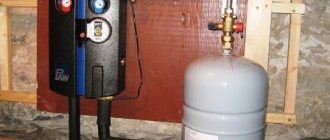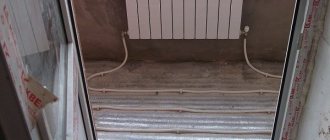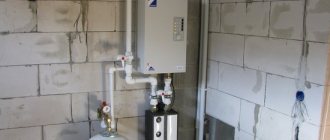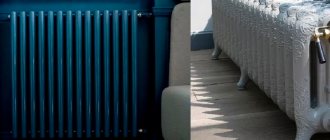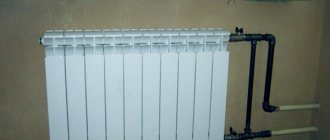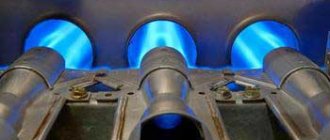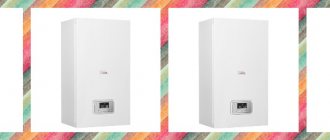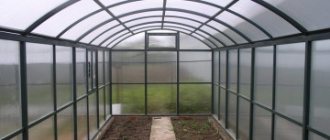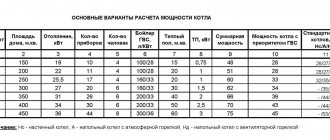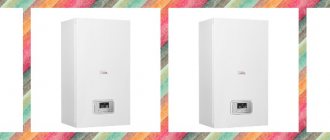The use of gas heating is based on a special boiler. It can be intended only to ensure normal operation of the heating system or additionally to heat the water.
The gas boiler in the apartment operates either using natural gas (propane-butane or methane) or other mixtures. Gas is relatively inexpensive. The boilers are easy to operate and can be automated if necessary.
Operating principle of the equipment
Gas autonomous heating in an apartment building is powered by a boiler installed in the apartment. To supply gas, electronic or piezo ignition is turned on. The spark created ignites the igniter, which burns until the device is turned off.
It is impossible to supply gas to the burner area when the igniter is not turned on due to the likelihood of an explosion. The igniter activates the main burner, which heats the coolant to a predetermined temperature.
When the required parameters are reached, the burner automatically turns off. As soon as the coolant temperature drops below a certain level, the thermal sensor is triggered and the gas supply is resumed.
Characteristics and features of wall-mounted double-circuit boilers
For a long time, by analogy with solid fuel boilers, gas heating boilers were only floor-mounted and were cumbersome. With the development of technology, they have a more advanced alternative - wall-mounted boilers that can heat large areas of up to 500-600 m². Compared to their power, they are characterized by compactness and light weight and can be placed in almost any room, not just in the boiler room. In most cases, when an additional technical room is not provided for in the layout, a wall-mounted heat generator is hung in the kitchen, but other options are also possible.
Although wall-mounted gas boilers have been actively used for many years, there is still an opinion that floor-standing units are more reliable.
EarringFORUMHOUSE Member
I talked with an understanding friend, he said that wall mounts last no more than 5-6 years, then they need to be replaced, floor mounts are more reliable. So?
Sergey BugaevAriston product specialist
The service life of a wall-mounted boiler is 12-15 years, depending on operating conditions. The most important thing is to properly monitor gas equipment.
Any boiler, regardless of configuration, needs proper operation and regular maintenance; anything can be “killed”.
Wall-mounted gas boilers come in two types.
- Single-circuit - with one heat exchanger, intended only for heating the home.
- Double-circuit - with two heat exchangers, they simultaneously heat the house and supply it with hot water.
When installing a single-circuit boiler for domestic hot water, it is necessary to install an independent water heating boiler or BKN (indirect heating boiler), which significantly increases the cost of the system, and if the house is small and without a boiler room, this is also inconvenient. Double-circuit boilers win in this regard, but they also have their own pitfalls.
Max_participant FORUMHOUSE
Everything is clear about the priority of a condensing-type boiler, but together with the BKN and the remote control system, the price with a well-known brand boiler goes over 100 thousand rubles. Therefore, from the point of view of finding the most cost-effective solution, I would like to clarify for myself in more detail all the negative aspects when choosing a double-circuit boiler (except for the inconvenience of using hot water simultaneously from 2 points of analysis), especially considering that the hot water supply will not be used so often and not for long: wash, take a shower, wash the dishes...
VladizForumHouse Member
Double-circuit boilers have a negative point - if the water quality is poor, the heat exchanger quickly fails.
Sergey BugaevProduct Specialist
As you mentioned, the main “disadvantage” of double-circuit boilers is the limitation on instantaneous heating power. If your hot water consumption is not so high, then there will be no problems. The second point is the load on the secondary heat exchanger; at high DHW temperatures it will gradually become clogged with scale, but the built-in anti-scale function, reducing the DHW temperature (it is better to use hot water without diluting) and water treatment will help here.
In recent years, more practical and environmentally friendly units with a closed combustion chamber that do not require a major chimney have become more popular among double-circuit gas boilers. Double-circuit gas boilers are as automated as possible and do not require constant monitoring. And if we consider the latest generation of “smart” equipment, it is not only configured individually, but also adapts to weather conditions and is controlled remotely via phone. When you go away for the weekend or on vacation, you no longer have to worry that the house will get cold or, on the contrary, that during the thaw the boiler will work at full capacity. If earlier manufacturers offered only traditional units, albeit improved, but not perfect, now there are two varieties on sale - both traditional and condensing gas boilers.
Types of gas boilers
To classify gas apartment heating, various factors are used - the location of the boiler in the room, the material used to make the heat exchanger.
Floor-standing
A floor-standing boiler does not necessarily have to be located on the floor. Sometimes they use platforms specially designed for this.
One of the varieties of floor-standing devices are steel fire-tube boilers. They are distinguished by high power and have good efficiency. The components of the heat exchanger are steel pipes that ensure normal circulation of the coolant.
Along with fire tube boilers, there are cast iron floor-standing gas boilers. Their heat exchangers are made of cast iron. Power is average (explained by the impressive weight of the heat exchanger). This type of boiler has a long service life.
Wall mounted
As for wall-mounted boilers, they are located directly on wall surfaces or a special frame. They are distinguished by their compactness and low power, which is quite enough for normal heating of rooms and water. Burners are usually made of tubular type, heat exchangers are made of steel or copper.
Autonomous wall-mounted gas heating saves a lot of usable space in the apartment. Some models have remote controls, which greatly increases the ease of use.
Review of popular manufacturers of gas boilers
Currently, gas boilers are produced by many domestic and foreign manufacturers. Let's look at the general characteristics of models from popular manufacturing companies that can be installed in an apartment.
| Manufacturer | Characteristic |
| VAILLANT (Germany) | Gas boilers "Vailant" can be purchased in a floor-standing or wall-mounted version. Available in naturally aspirated and turbocharged models. Single-circuit VU for combination with a cylinder water heater and double-circuit VUW gas boilers are available. |
| BAXI (Italy) | Built-in diagnostic system that automatically detects system malfunctions. Reliability and safety. Two temperature control ranges (you can switch the boiler from full power mode (30–85 °C) to the “warm floor” operating mode (30–45 °C)). Environmentally friendly: the boiler reduces harmful emissions into the atmosphere by 15–20%. Economical: energy consumption is reduced by up to 35% during the heating season. High performance. Simplicity and flexibility of settings. |
| BUDERUS (Germany) | The brand has been on the market since 2004. Includes both convection and more modern and efficient condensing wall-mounted gas boilers. Suitable for private houses, apartments, country houses and country cottages. Safe and reliable design. Economical. Good value. |
| VIESSMANN (Germany) | Single-circuit and double-circuit models. With open or closed combustion chamber. The boiler rated power range is 23 – 29 kW. All modifications are equipped with a control controller and an efficient and reliable heat exchanger. A smooth change in power is implemented depending on the heat demand. Powerful and economical units. Functional and easy to use. Boilers of this brand are the optimal solution for heating rooms and preparing hot water in private houses, cottages, and apartments. |
| PROTHERM (Slovakia) | Guaranteed reliability is pleasantly complemented by ease of maintenance and low operating costs. Technological sophistication and durability. Compliance with European standards. Stylish design. In addition to boilers, the company supplies the market with more than 2,000 components. |
Thus, a gas boiler in the apartment will create comfortable living conditions all year round. The main thing is to go through all stages of approval and installation.
Features of use
For normal operation of a gas boiler and maintenance of combustion, an air mass is required, which can be taken directly from the room where the equipment is installed, or from the outside. Autonomous heating using a natural draft boiler is not allowed in all rooms. They must necessarily comply with current standards.
With forced draft the situation is somewhat different. Air intake with subsequent removal of combustion products is carried out from the street or a special room. The process is carried out by a fan. The exhaust goes through air ducts with a small diameter. With such traction, the device can be installed in an apartment or in the basement of a country house.
Air intake.
How to install a gas boiler for heating in an apartment
It’s not worth saying much about the operating principle of a gas boiler, since everything is already clear there. Water enters the heat exchanger, then it is heated to the required temperature, and then distributed throughout the heating system.
What you need to have or do before installing individual heating:
- In order to install gas heating in an apartment, you must first obtain permission for this (from the gas service).
- Select, calculate and then purchase the necessary equipment for individual heating of the room.
- The room or area where the boiler will be located must be prepared accordingly. You can make the appropriate repairs, punch a hole for the coaxial pipe if there is no chimney, etc.
- Thanks to the gas heating system in the apartment, you will no longer depend on a centralized gas main.
- You also need to think about ventilation of the room, as this guarantees the safety of using the unit for all family members.
Of course, it will not be possible to quickly install an individual heating system, since collecting documents according to the list will take a lot of time.
Rice. 4 Autonomous heating in the apartment
Below are the conditions under which gas heating can be installed in apartments:
- An individual gas boiler in an apartment can be installed in rooms with an area of more than 4 m², but in no case less.
- There should also be more natural light in the room where the individual heating system will be located, that is, the presence of a window (with a window that will open for ventilation) is mandatory.
- There must be a cold water pipeline.
- For individual gas heating you need a chimney. If this is not the case in a high-rise building, then you can install a coaxial pipe that passes through the wall.
- When the gas unit is operating, ventilation should also work well.
If you follow all these simple rules, then the installation of individual heating in an apartment will take place quickly and without any problems. You can install an individual system yourself, but it’s still not worth it - it’s better to contact a specialist.
Autonomous heating in the apartment
What does the number of circuits affect?
Gas heating in an apartment building, based on the number of circuits, can be double-circuit or single-circuit. What's the difference? Single-circuit ones perform only one task - they warm up the working fluid in heating systems. To increase the temperature of water used for household purposes, it is necessary to additionally install a capacitive water heater. Type of heating – indirect.
Double-circuit boilers cope well with both heating rooms and water. The circuit is heated to the required temperature in a flow-type heat exchanger. An alternative is a cylinder water heater.
Gas boiler and safety
As soon as you decide to switch your apartment to autonomous heating, you need to carefully study all the nuances of this possibility, strictly adhering to safety rules. Remember: water and hot gases must flow countercurrently in the boiler heat exchanger, otherwise the device may explode with any automation. Therefore, during installation it is so important not to confuse cold and hot pipes.
After hydropiping the system, carefully inspect it again. If antifreeze was poured into the heating system, be sure to drain it and rinse the pipes twice with clean water. Antifreeze in water is also very explosive.
Install filters for rough purification of passing water, which are placed at the lowest points of the system. Otherwise, there is a danger of dirt deposits accumulating between the fins of the heat exchanger, not to mention high gas consumption.
Sludge is drained through mud traps at the beginning and end of the heating season, simultaneously checking the condition of the entire system.
If your boiler has a built-in expansion tank and a deaeration system, then the previous expansion tank must be removed by tightly closing the air valve. Before performing the procedure, be sure to check its condition: air leaks can also create a dangerous situation.
Requirements for the chimney and other parts
The chimney needs to be made of steel, preferably stainless. There must be cleanout hatches and the ability to drain condensate. At the bottom of the chimney there is a pocket intended for deposits.
The outside of the chimney is subject to additional thermal insulation. The insulation material must be protected from precipitation and condensation.
The chimney should be 2-3 cm higher than the boiler outlet. The height of the chimney must be at least 5 m. The chimney is installed in the receiving plate of the vapor trap. In this case, condensate should not get inside the boiler.
The pipe cut should not fall on the wind support area.
What about an atmospheric expansion tank? It must be installed at the highest point of the entire structure. It is preferable that it be located inside the room.
The boiler supply pipeline must be equipped with a safety group and a thermometer. The boiler itself is strongly not recommended to be installed in openings, niches and other similar hard-to-reach places.
Accommodation requirements
These requirements will directly apply to the room in which the gas boiler is to be located. What does the instruction manual say about this? Thus, the room must have a total area of more than 7.5 m². Ceiling height - at least 2.2 m.
Diagram of a gas boiler from Vaillant.
In addition, the room must have a window that can be opened if necessary. It should go outside. This is required by fire safety.
As for the door in this room, it should open in the direction of movement from the room. There should be no switches in the room itself. They should be moved outside the room.
A ventilation system (supply and exhaust) is required. Approximately 15 m² of air per 1 m² of gas burned is required. Three air exchanges are also needed.
When installing the boiler itself in a room, fire safety precautions must be strictly observed. So, from the boiler to the combustible elements of the room, you need to measure a distance of no less than 25 cm. As for non-combustible elements, a distance of 5 cm is allowed here.
The distance between the chimney and combustible parts is 40 cm, and between the chimney and non-combustible parts - 15 cm.
Related article: How to wash tulle to make it white
The gas boiler must be installed on a perfectly flat surface with no slopes. This is important for safe use.
